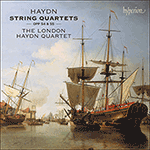
Welcome to Hyperion Records, a British classical label devoted to presenting high-quality recordings of music of all styles and from all periods from the twelfth century to the twenty-first.
Hyperion offers both CDs, and downloads in a number of formats. The site is also available in several languages.
Please use the dropdown buttons to set your preferred options, or use the checkbox to accept the defaults.

| The London Haydn Quartet» More |
Written against the background of a slow march, the Adagio ma non troppo exudes a characteristically Haydnesque mixture of sweetness and solemnity. Formally it consists of an unsually extended theme, two variations and a murmuring coda. In the first variation the second violin takes the melody beneath the first violin’s decorative countermelody—a texture characteristic of Opp 54 and 55—while the second variation unfolds in free canonic imitation. The jaunty swagger of the minuet is repeatedly undermined by drooping chromatic lines. In a variant on Haydn’s favourite ‘ending-as-beginning’ pun, the trio then puts a lyrical cast on the minuet’s exuberant cadential phrase. For his finale Haydn writes a scampering, rhythmically brilliant jig, akin in spirit to the finale of the ‘Razor’ Quartet. This is opera buffa by other means, full of delighted, quickfire repartee and energizing counterpoint that ensures fair treatment for all four instruments.
from notes by Richard Wigmore © 2017
Écrit sur un arrière-plan de marche lente, l’Adagio ma non troppo respire un mélange de douceur et de solennité caractéristique de Haydn. Sur le plan formel, il se compose d’un thème d’une longueur inhabituelle, de deux variations et d’une coda murmurante. Dans la première variation, le second violon joue la mélodie sous le contrechant décoratif du premier violon—une texture caractéristique des op.54 et 55—alors que la seconde variation se déroule en imitation libre en canon. L’air fanfaron et enjoué du menuet est sans cesse sapé par des lignes chromatiques tombantes. Dans une variante du jeu cher à Haydn consistant à terminer comme il avait commencé, le trio met alors une empreinte lyrique sur la phrase cadentielle exubérante du menuet. Pour son finale, Haydn écrit une gigue galopante, brillante sur le plan rythmique, dont l’esprit est proche de celui du finale du Quatuor «le Rasoir». C’est de l’opéra bouffe avec un autre moyen d’expression, plein de répartie rapide et de contrepoint énergisant qui assure un traitement équitable à chacun des quatre instruments.
extrait des notes rédigées par Richard Wigmore © 2017
Français: Marie-Stella Pâris
Das Adagio ma non troppo, dem ein langsamer Marschtritt zugrunde liegt, verströmt die typisch Haydn’sche Mischung von lieblichem und feierlichem Ton. Formal besteht es aus einem ungewöhnlich langen Thema, zwei Variationen und einer halblauten Coda. In der ersten Variation übernimmt die 2. Violine das Thema unter einer auszierenden Gegenmelodie der 1. Violine—eine Satzweise, die die Quartette op. 54 und 55 geradezu kennzeichnet—, während die zweite Variation sich in freier kanonischer Imitation entfaltet. Der kecke Tonfall des Menuetts wird immer wieder von fallenden chromatischen Linien getrübt. Auf abermals neue Weise macht Haydn im Trio das Ende zum Anfang: Es wendet die übermütige Kadenzformel des Menuetts ins Lyrische. Als Finale dient eine ausgelassene, rhythmisch brillante Gigue, die im Geist dem Finale des „Rasierquartetts“ verwandt ist—Opera buffa mit anderen Mitteln, voller freudiger und schlagfertiger instrumentaler Wechselrede und treibendem Kontrapunkt, der jedem Instrument zu seinem Recht verhilft.
aus dem Begleittext von Richard Wigmore © 2017
Deutsch: Friedrich Sprondel
 Haydn: String Quartets Opp 54 & 55 Haydn: String Quartets Opp 54 & 55More masterly Haydn from The London Haydn Quartet in this economically priced set of six great quartets from the late 1780s.» More |

